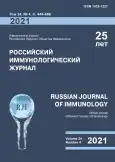Extended haplotypes based on rare single nucleotide polymorphisms of TNFA and HLA DRB1 associated with rheumatoid arthritis
- 作者: Stashkevich D.S.1, Khromova E.B.2, Devald I.V.2,3, Khodus E.A.4, Burmistrova A.L.2
-
隶属关系:
- Chelyabinsk State University
- Chelyabinsk State University
- South Ural State Medical University
- Kinzersky Clinic
- 期: 卷 24, 编号 4 (2021)
- 页面: 555-562
- 栏目: SHORT COMMUNICATIONS
- URL: https://journals.rcsi.science/1028-7221/article/view/120210
- DOI: https://doi.org/10.46235/1028-7221-1053-EHB
- ID: 120210
如何引用文章
全文:
详细
Rheumatoid arthritis (RA) is a multifactorial disease, with genetic component based on intergenic interactions leading to the formation of gene networks. The current trend in RA immunogenetic studies is to assess the gene-to-gene interactions. Among possible genetic factors contributing to RA development, the genes of main histocompatibility complex (HLA class II) play a fundamental role. TNFA gene is among possible candidate genes providing susceptibility to this disorder and contributing to its immune pathogenesis. The special location of this gene suggests arrangement of extended TNFA – HLA haplotypes. This work analyzed the distribution features of two-locus SNP haplotypes (TNFA and HLA DRB1) for their association with rheumatoid arthritis in Russians. The following methods were used: DNA isolation, PCR-based genotyping, RFLP analysis with electrophoretic detection. Calculation of two-locus haplotypes frequencies and linkage disequilibrium (D’; χ2; p) was carried out using the EM algorithm in the Arlequin ver 3.5 program. Comparison of paired samples was carried out using standard immunogenetic criteria. The significance level was < 0.05. Analysis of the data showed that the two-locus haplotypes -1031T/C and -863C/A TNFA were not associated with predisposal for rheumatoid arthritis in Russian population sample. The haplotypes associated with predisposition for RA were TNFA -863*a – HLA DRB1*03, TNFA -1031*t – HLA DRB1*04, TNFA -1031*t – HLA DRB1*04. Meanwhile, TNFA -1031*t – HLA DRB1*15; TNFA -1031*t -HLA DRB1*11 proved to be protective haplotypes. Our study showed that, in addition to individual HLA II alleles, the predisposal or resistance to rheumatoid arthritis may be promoted by haplotypes of rare SNPs at positions -1031, -863 C/A of TNFA gene, and HLA DRB1.
作者简介
D. Stashkevich
Chelyabinsk State University
编辑信件的主要联系方式.
Email: stashkevich_dary@mail.ru
PhD (Biology), Associate Professor, Dean, Faculty of Biology
454021, Russian Federation, Chelyabinsk, Moldavskaya str., 25, apt 15
Phone: 7 (351) 799-71-54
俄罗斯联邦E. Khromova
Chelyabinsk State University
Email: eb_sh@mail.ru
PhD (Biology), Assistant Professor, Department of Microbiology, Immunology and General Biology; Faculty of Biology
Chelyabinsk
俄罗斯联邦I. Devald
Chelyabinsk State University;South Ural State Medical University
Email: inessa.devald@gmail.com
PhD (Medicine), Associate Professor, Department of Microbiology, Immunology and General Biology, Faculty of Biology; Associate Professor, Department of Therapy
Chelyabinsk
俄罗斯联邦E. Khodus
Kinzersky Clinic
Email: khoduslena@gmail.com
PhD (Medicine), Clinical Rheumatologist, Professor
Chelyabinsk
A. Burmistrova
Chelyabinsk State University
Email: burmal@csu.ru
PhD, MD (Medicine), Head, Department of Microbiology, Immunology and General Biology, Faculty of Biology
Chelyabinsk
参考
- Кужир Т.Д. Полигенная природа ревматоидного артрита // Экологическая генетика, 2019. Т. 17, № 4. C. 77-90.
- Насонов Е.Л. Проблемы иммунопатологии ревматоидного артрита: эволюция болезни // Научно-практическая ревматология, 2017. Т. 55, № 3. С. 277-294.
- Сташкевич Д.С., Девальд И.В. Анализ двухлокусных гаплотипов HLA и TNFA у больных ревматоидным артритом башкирской популяции // Вестник Уральской медицинской академической науки, 2011. № 2-2 (35). С. 116-117.
- Суслова Т.А., Бурмистрова А.Л., Хромова Е.Б., Сташкевич Д.С., Девальд И.В., Исаканова А.О., Болдырева М.Н., Алексеев Л.П. Генетическая предрасположенность к ревматоидному артриту: роль генов и гаплотипов HLA класса II // Иммунология, 2008. Т. 29, № 3. С. 137-140.
- Excoffier L., Slatkin M. Maximum-likelihood estimation of molecular haplotype frequencies in a diploid population. Mol. Biol. Evol., 1995, Vol. 12, no. 5, pp. 921-927.
- Gabriel M.L., Braga F.B., Cardoso M.R., Lopes A.C., Piatto V.B., Souza A.S. The association between pro- and anti-inflammatory cytokine polymorphisms and periventricular leukomalacia in newborns with hypoxic-ischemic encephalopathy. J. Inflamm. Res., 2016, Vol. 9, pp. 59-67.
- Karami J., Aslani S., Jamshidi A., Garshasbi M., Mahmoudi M. Genetic implications in the pathogenesis of rheumatoid arthritis; an updated review. Gene, 2019, Vol. 702, pp. 8-16.
- Mikhaylenko D.S., Nemtsova M.V., Bure I.V. Genetic polymorphisms associated with rheumatoid arthritis development and antirheumatic therapy response. Int. J. Mol. Sci., 2020, Vol. 21, no. 14, 4911. doi: 10.3390/ijms21144911.
- Noack M., Miossec P. Selected cytokine pathways in rheumatoid arthritis. Semin. Immunopathol., 2017, Vol. 39, no. 4, pp. 365-383.
- Ridgley L.A., Anderson A.E., Pratt A.G. What are the dominant cytokines in early rheumatoid arthritis? Curr. Opin. Rheumatol., 2018, Vol. 30, no. 2, pp. 207-214.
- Sadaf T., John P., Bhatti A., Malik J.M. Lack of association of -863C/A (rs1800630) polymorphism of tumor necrosis factor-a gene with rheumatoid arthritis. Arch. Med. Sci., 2019, Vol. 15, no. 2, pp. 531-536.
- Sandoval-Pinto E., Padilla-Gutiérrez J.R., Valdés-Alvarado E., García-González I.J., Valdez-Haro A., Francisco Muñoz-Valle J., Flores-Salinas H. E., Brennan-Bourdon L.M., Valle Y. Association of the -1031T>C polymorphism and soluble TNF-α levels with Acute Coronary Syndrome. Cytokine, 2016, Vol. 78, pp. 37-43.
- Suslova T.A., Burmistrova A.L., Vavilov M.N., Chernova M.S., Khromova E.B., Belyaeva S.V., Zaripova O.N., Stashkevich D.S., Galkin A.S., Darke C. HLA gene and haplotype frequencies in a nagaybaks population from the Chelyabinsk region (Russian South Urals). Hum. Immunol., 2017, Vol. 78, no. 10, pp. 595-601.
补充文件







